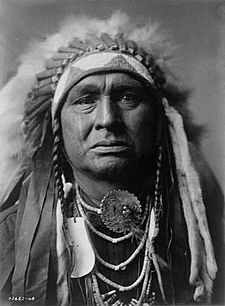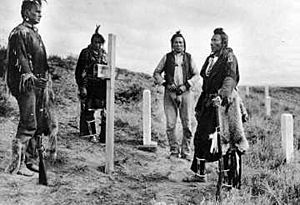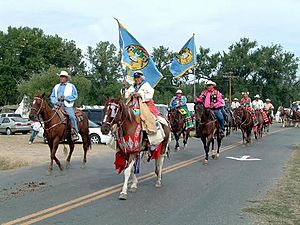White Man Runs Him facts for kids
Quick facts for kids
White Man Runs Him
|
|
|---|---|
| Mahr-Itah-Thee-Dah-Ka-Roosh | |

Edward S. Curtis portrait of White Man Runs Him, c. 1908
|
|
| Crow leader | |
| Personal details | |
| Born | c. 1858 Lodge Grass, Montana |
| Died | June 2, 1929 (aged 70–71) Crow Indian Reservation |
| Resting place | Little Bighorn Battlefield |
| Spouses | Pretty Medicine Pipe, d. Apr. 2, 1943 |
| Relations | Stepgrandfather of Joe Medicine Crow; grandfather of Pauline Small; great-grandfather of Janine Pease |
| Parents | Bull Chief, Offers Her Red Cloth |
| Known for | Scout for George Armstrong Custer at the Battle of the Little Bighorn |
| Nickname | White Buffalo That Turns Around |
White Man Runs Him, whose Crow name was Mahr-Itah-Thee-Dah-Ka-Roosh, was born around 1858 and passed away on June 2, 1929. He was a brave Crow scout who worked with George Armstrong Custer. This was during a big army mission in 1876 against the Sioux and Northern Cheyenne tribes. This mission ended in the famous Battle of the Little Bighorn.
Contents
Growing Up and Becoming a Scout
White Man Runs Him was also known as White Buffalo That Turns Around. He was born into the Big Lodge Clan of the Crow Nation. His parents were Bull Chief and Offers Her Red Cloth.
When he was about 18 years old, he decided to join the United States Army as a scout. This happened on April 10, 1876. The army was fighting against the Sioux and Northern Cheyenne, who were old enemies of the Crow people.
Serving as a Scout for Custer
White Man Runs Him officially joined the army on April 10, 1876. He signed up for six months at the Crow Agency in Montana Territory. He was part of the 7th United States Infantry.
On June 21, 1876, he moved to Custer's Seventh U.S. Cavalry. He was one of six Crow warrior scouts. The other scouts included Goes Ahead, Curly, Hairy Moccasin, White Swan, and Half Yellow Face. Half Yellow Face was the leader of the scouts.
White Man Runs Him helped scout for Lt. Charles Varnum's group in the days before the big battle.
The Crow's Nest View
Early on the morning of June 25, 1876, White Man Runs Him and the other Crow scouts went with Varnum and Custer to a high spot called the Crow's Nest. From there, they could see the Little Bighorn valley from about 17 miles away.
The scouts saw signs of a very large group of horses and smoke from many morning fires. The main camp was hidden in the valley. The Crow scouts told Custer that the camp was huge.
Custer decided to attack anyway. He was worried that the Sioux and Cheyenne warriors had already seen his 650-man force. He thought if he didn't attack quickly, the villagers would scatter. This would prevent the army from having the fight they wanted.
The Battle Begins
According to White Man Runs Him's own stories, Custer sent Major Marcus Reno's group to attack the village first. Then, Custer headed down Medicine Trail Creek to fight the Sioux and Cheyenne.
White Man Runs Him said that he and the other Crow scouts wanted to follow Custer into the battle. However, their chief scout, Mitch Boyer, told them to go back and join the pack train instead.
There is another story that says the Crow scouts believed they were about to die. They thought they couldn't win against such a large Sioux force. So, they took off their army uniforms and put on their traditional Crow war clothes. When Custer asked why, they said they wanted to die as warriors, not as soldiers. Custer was angry. He thought they were giving up. So, he sent them away about an hour before the final battle began.
White Man Runs Him went to a ridge with Goes Ahead, Hairy Moccasin, and Strikes That Bear (an Arikara scout). They joined Major Reno's group. They fought briefly but survived the battle. Later, White Man Runs Him joined Colonel John Gibbon's group.
Life After the Battle

After the Battle of the Little Bighorn, White Man Runs Him lived on the Crow reservation near Lodge Grass, Montana.
He was the step-grandfather of Joe Medicine Crow. Joe Medicine Crow became a famous Crow tribal historian. He used his grandfather's stories to write about the battle. White Man Runs Him was also the grandfather of Pauline Small. Pauline Small was the first woman elected to office in the Crow Tribe of Indians.
Because he survived the Little Bighorn battle, White Man Runs Him became a bit famous later in his life. He even appeared briefly in a 1927 Hollywood movie called The Red Raiders.
White Man Runs Him spent the rest of his life on the Crow Indian Reservation. This was in the Big Horn Valley region of Montana. It was only a few miles from where the famous battle happened. He passed away there in 1929.
Remembering White Man Runs Him
White Man Runs Him was buried in the cemetery at the Little Bighorn Battlefield. His stories about the battle are shared in books like "The Custer Myth" by C. Graham and It Is a Good Day to Die: Indian Eyewitnesses Tell the Story of the Battle of the Little Bighorn.
A small stream, or slough, near Lodge Grass, Montana, is named after him. It is called Baaishtashíilinkuluush Alaaxúa, which means "Where Whiteman Runs Him Hid." A valley, or coulee, called Baaishtashíilinkuluush Isalasáh te, is also named after him and is known as "Whiteman's Creek."


